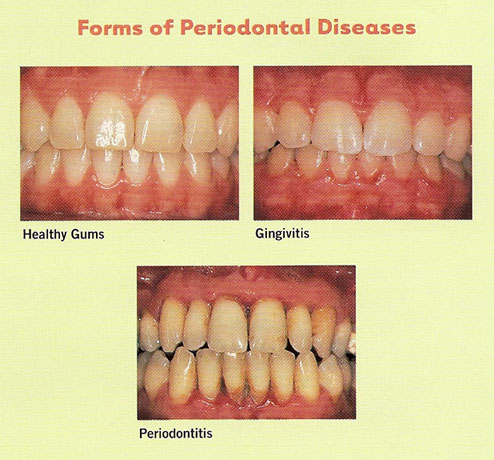What causes periodontal disease?
Plaque that is not removed can cause the gum tissue to become irritated and inflamed, making the gums swollen or causing them to bleed. This is called gingivitis, the early stage of periodontal (gum) disease. The good news is that gingivitis is reversible with professional teeth cleaning in the dental office and good oral hygiene at home.
If periodontal disease is left untreated, the gums may pull away from the teeth and form pockets or spaces between the teeth and gums that usually become infected. Without treatment, the infection can progress, bone loss can occur and teeth may become loose, fall out or require extraction.
Twice-daily brushing and cleaning between the teeth daily with floss or other interdental cleaners help remove food particles and plaque from the mouth and are essential in preventing both tooth decay and periodontal disease.
Periodontal Disease (Gum Disease)
Periodontal (gum) diseases are caused by bacterial infections that attack the gums, tissue and bone. When plaque is not removed it can harden into a rough, porous deposit called calculus, or tartar. It can only be removed when teeth are cleaned in the dental office. Tartar that forms below (under) the gumline makes it more difficult to remove plaque film and may interfere with the attachment of the teeth to the gums. This can create conditions that lead to chronic inflammation and infection.
An early sign of periodontal disease is gums that bleed easily, especially when teeth are brushed. If not treated at an early stage, serious problems can result. Eventually, bony support can be lost and teeth may become loose, fall out or require extraction.
Periodontal diseases can occur at any age. Several forms of periodontal disease can affect even teenagers. Adolescents may need reminders about practicing good oral hygiene. It is important that both children and adults have regular dental checkups.
Plaque that is not removed can cause the gum tissue to become irritated and inflamed, making the gums swollen or causing them to bleed. This is called gingivitis, the early stage of periodontal (gum) disease. The good news is that gingivitis is reversible with professional teeth cleaning in the dental office and good oral hygiene at home.
If periodontal disease is left untreated, the gums may pull away from the teeth and form pockets or spaces between the teeth and gums that usually become infected. Without treatment, the infection can progress, bone loss can occur and teeth may become loose, fall out or require extraction.
Twice-daily brushing and cleaning between the teeth daily with floss or other interdental cleaners help remove food particles and plaque from the mouth and are essential in preventing both tooth decay and periodontal disease.
Periodontal Disease (Gum Disease)
Periodontal (gum) diseases are caused by bacterial infections that attack the gums, tissue and bone. When plaque is not removed it can harden into a rough, porous deposit called calculus, or tartar. It can only be removed when teeth are cleaned in the dental office. Tartar that forms below (under) the gumline makes it more difficult to remove plaque film and may interfere with the attachment of the teeth to the gums. This can create conditions that lead to chronic inflammation and infection.
An early sign of periodontal disease is gums that bleed easily, especially when teeth are brushed. If not treated at an early stage, serious problems can result. Eventually, bony support can be lost and teeth may become loose, fall out or require extraction.
Periodontal diseases can occur at any age. Several forms of periodontal disease can affect even teenagers. Adolescents may need reminders about practicing good oral hygiene. It is important that both children and adults have regular dental checkups.
Types of Periodontal Diseases
Gingivitis
Gingivitis is the mildest form of periodontal disease. It causes the gums to become red, swollen, and bleed easily. There is usually little or no discomfort at this stage. Gingivitis is reversible with professional treatment and good oral care at home.
Chronic Periodontitis
Chronic periodontitis is a form of periodontal disease that results in inflammation within the supporting tissues of the teeth. Patients experience progressive loss of tissue attachment and bone. Chronic periodontitis is characterized by pocket formation and/or recession of gum tissue and is the most frequently occurring form of periodontitis. It is prevalent in adults, but can occur at any age. Progression of attachment loss usually occurs slowly, but periods of rapid progression can occur.
Aggressive Periodontitis
Aggressive periodontitis is a highly destructive form of periodontal disease that occurs in patients who are otherwise clinically healthy. Common features include rapid loss of tissue attachment and destruction of the bone. This disease may occur in localized or generalized patterns.
Periodontitis as a Manifestation of Systemic Diseases
This form of periodontitis is associated with one of several systemic diseases, such as diabetes. Patients who have rare but specified blood diseases or genetic disorders frequently show signs of periodontal diseases..
Necrotizing Periodontal Diseases
Necrotizing periodontal diseases are infections characterized by necrosis (death) of gingival tissues, periodontal ligament and alveolar bone. These lesions are most commonly associated with pain, bleeding, and a foul odor. Contributing factors can include emotional stress, tobacco use and HIV infection..
How are periodontal diseases treated?
Scaling and Root Planing
Surgical intervention by a periodontist

